桥接系统混棒与双棒结构治疗股骨及胫骨骨折的生物力学特点
桥接组合式内固定系统治疗股骨干骨折术后骨不连的临床观察
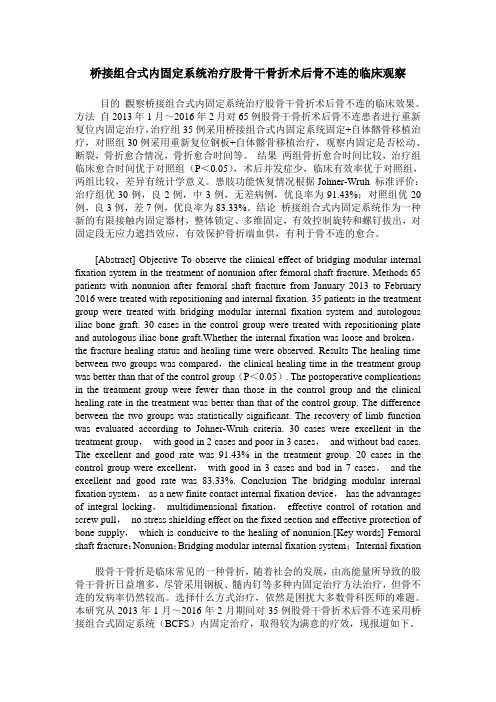
桥接组合式内固定系统治疗股骨干骨折术后骨不连的临床观察目的觀察桥接组合式内固定系统治疗股骨干骨折术后骨不连的临床效果。
方法自2013年1月~2016年2月对65例股骨干骨折术后骨不连患者进行重新复位内固定治疗,治疗组35例采用桥接组合式内固定系统固定+自体髂骨移植治疗,对照组30例采用重新复位钢板+自体髂骨移植治疗,观察内固定是否松动、断裂,骨折愈合情况,骨折愈合时间等。
结果两组骨折愈合时间比较,治疗组临床愈合时间优于对照组(P<0.05),术后并发症少,临床有效率优于对照组,两组比较,差异有统计学意义。
患肢功能恢复情况根据Johner-Wruh 标准评价:治疗组优30例,良2例,中3例,无差病例,优良率为91.43%;对照组优20例,良3例,差7例,优良率为83.33%。
结论桥接组合式内固定系统作为一种新的有限接触内固定器材,整体锁定、多维固定,有效控制旋转和螺钉拔出,对固定段无应力遮挡效应,有效保护骨折端血供,有利于骨不连的愈合。
[Abstract] Objective To observe the clinical effect of bridging modular internal fixation system in the treatment of nonunion after femoral shaft fracture. Methods 65 patients with nonunion after femoral shaft fracture from January 2013 to February 2016 were treated with repositioning and internal fixation. 35 patients in the treatment group were treated with bridging modular internal fixation system and autologous iliac bone graft. 30 cases in the control group were treated with repositioning plate and autologous iliac bone graft.Whether the internal fixation was loose and broken,the fracture healing status and healing time were observed. Results The healing time between two groups was compared,the clinical healing time in the treatment group was better than that of the control group(P<0.05). The postoperative complications in the treatment group were fewer than those in the control group and the clinical healing rate in the treatment was better than that of the control group. The difference between the two groups was statistically significant. The recovery of limb function was evaluated according to Johner-Wruh criteria. 30 cases were excellent in the treatment group,with good in 2 cases and poor in 3 cases,and without bad cases. The excellent and good rate was 91.43% in the treatment group. 20 cases in the control group were excellent,with good in 3 cases and bad in 7 cases,and the excellent and good rate was 83.33%. Conclusion The bridging modular internal fixation system,as a new finite contact internal fixation device,has the advantages of integral locking,multidimensional fixation,effective control of rotation and screw pull,no stress shielding effect on the fixed section and effective protection of bone supply,which is conducive to the healing of nonunion.[Key words] Femoral shaft fracture;Nonunion;Bridging modular internal fixation system;Internal fixation 股骨干骨折是临床常见的一种骨折,随着社会的发展,由高能量所导致的股骨干骨折日益增多,尽管采用钢板、髓内钉等多种内固定治疗方法治疗,但骨不连的发病率仍然较高。
骨折愈合过程中的生物力学研究
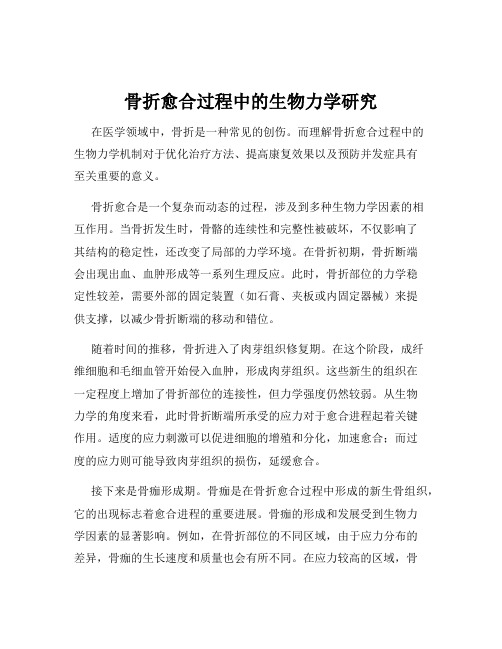
骨折愈合过程中的生物力学研究在医学领域中,骨折是一种常见的创伤。
而理解骨折愈合过程中的生物力学机制对于优化治疗方法、提高康复效果以及预防并发症具有至关重要的意义。
骨折愈合是一个复杂而动态的过程,涉及到多种生物力学因素的相互作用。
当骨折发生时,骨骼的连续性和完整性被破坏,不仅影响了其结构的稳定性,还改变了局部的力学环境。
在骨折初期,骨折断端会出现出血、血肿形成等一系列生理反应。
此时,骨折部位的力学稳定性较差,需要外部的固定装置(如石膏、夹板或内固定器械)来提供支撑,以减少骨折断端的移动和错位。
随着时间的推移,骨折进入了肉芽组织修复期。
在这个阶段,成纤维细胞和毛细血管开始侵入血肿,形成肉芽组织。
这些新生的组织在一定程度上增加了骨折部位的连接性,但力学强度仍然较弱。
从生物力学的角度来看,此时骨折断端所承受的应力对于愈合进程起着关键作用。
适度的应力刺激可以促进细胞的增殖和分化,加速愈合;而过度的应力则可能导致肉芽组织的损伤,延缓愈合。
接下来是骨痂形成期。
骨痂是在骨折愈合过程中形成的新生骨组织,它的出现标志着愈合进程的重要进展。
骨痂的形成和发展受到生物力学因素的显著影响。
例如,在骨折部位的不同区域,由于应力分布的差异,骨痂的生长速度和质量也会有所不同。
在应力较高的区域,骨痂往往更加致密和坚固,以适应较大的力学负荷;而在应力较低的区域,骨痂可能相对疏松。
在骨折愈合的后期,即骨痂改造塑形期,骨骼会根据其承受的力学负荷进行自我调整和优化。
这个过程类似于“雕刻”,通过骨吸收和骨重建,使骨骼的结构和力学性能逐渐恢复到正常水平。
在此阶段,如果力学环境发生异常变化(如长期的废用或过度的负荷),都可能导致骨骼的重塑异常,从而影响骨折的最终愈合效果。
从生物力学的角度来看,骨折固定的稳定性是影响愈合的一个关键因素。
不稳定的固定会导致骨折断端的微动过大,干扰正常的愈合过程;而过于坚强的固定则可能抑制骨痂的形成和重塑。
因此,在骨折治疗中,需要根据骨折的类型、部位和患者的个体情况,选择合适的固定方式和固定强度,以提供既稳定又有利于愈合的力学环境。
桥接组合式内固定系统在肱骨及胫骨骨折中的应用研究

桥接组合式内固定系统在肱骨及胫骨骨折中的应用研究作者:廖建晖冯帅华吴官保来源:《今日健康》2014年第07期【摘要】目的:探讨分析桥接组合式内固定系统在肱骨及胫骨骨折中的临床应用价值。
方法:回顾性分析湖南省中医药研究院附属医院2013年所收治的20例使用桥接组合式内固定系统治疗肱骨及胫骨骨折患者的诊疗资料,分析治疗效果。
结果:桥接组合式内固定系统有利于提高治疗的安全性,优良率达到90.0%。
并发症发生率为0.0%。
结论:桥接组合式内固定系统有利于患者骨折的愈合,避免金属断裂、应力遮挡等问题。
【关键词】肱骨胫骨骨折临床疗效【中图分类号】 R44 【文献标识码】 A 【文章编号】 1671-5160(2014)07-0039-011 资料与方法1.1 临床资料回顾性分析湖南省中医药研究院附属医院2013年6月至10月所收治的20例使用桥接组合式内固定系统治疗肱骨及胫骨骨折患者的诊疗资料,男性患者10例,女性患者10例,平均年龄(43.4±6.1)岁,平均体重(51.8±7.6)千克,平均患病时间(6.9±2.0)天。
20例患者都经过X线检查确诊为肱骨及胫骨骨折。
患病原因:摔伤患者4例,砸伤患者5例,高处坠落伤患者4例,交通事故伤7例。
20例患者中,胫骨骨折患者10例,其中,7例患者合并腓骨骨折,3例患者Ⅰ期开放骨折,6例患者邻近关节骨折,3例患者骨不连;肱骨骨折患者10例,其中,3例患者合并桡神经损伤,4例患者邻近关节骨折,2例患者骨不连。
1.2 方法所有患者都积极配合护理人员做好手术前的准备,患者进入手术室后,护理人员要密切监测患者的生命体征,帮助患者做全麻气管内插管,桥接组合式内固定系统主要是由锁定螺钉、连接块、固定棒组成[1]。
所有患者都要进行闭合微创固定、有限切口,骨折部位做小切口,进行骨折复位,在小切口中插入连接块和固定棒,螺钉置入的位置在皮肤切口附近10毫米处,在锁定螺钉导向器的引导下,使用电钻打孔,然后置入螺钉,剩余的螺钉采用同种方法依次固定好。
桥接组合式内固定系统在肱骨及胫骨骨折中的应用分析
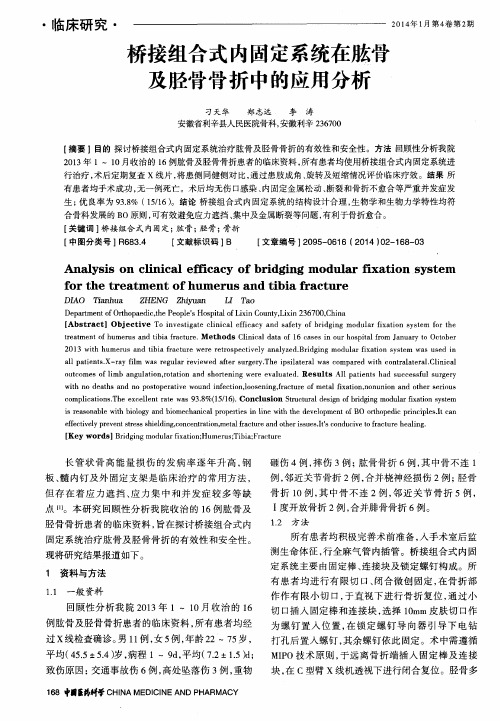
生; 优 良率为 9 3 . 8 %( 1 5 / 1 6 o结论 桥接组合式内固定系统的结构设计合理 , 生物学和生物力学特性均符
合骨科发展的 B O原则 , 可有效避免应力遮挡 、 集 中及金属断裂等问题 , 有利于骨折愈合。 【 关键词 】 桥接组合式 内固定; 肱骨 ; 胫骨 ; 骨折 【 中图分类号 】 R 6 8 3 . 4 [ 文献标识码 】 B 【 文章编号 】 2 0 9 5 — 0 6 1 6( 2 0 1 4) O 2 — 1 6 8 — 0 3
o u t c o me s o f l i mb a n g u l a t i o n , r o t a t i o n a n d s h o r t e n i n g w e r e e v a l u a t e d. Re s ul t s Al l p a t i e n t s h a d s u c c e s s f u l s u r g e r y wi t h n o d e a t h s a n d n o p o s t o p e r a t i v e wo u n d i n f e c t i o n , l o o s e n i n g , f r a c t u r e o f me t a l f i x a t i o n , n o n u n i o n a n d o t h e r s e r i o u s
DI AO T i a n h De p a r t me n t o f Or t h o p a e d i c , t h e P e o p l e ’ S Ho s p i t a l o f L i x i n C o u n t y , L i x i n 2 3 6 7 0 0 , C h i n a
反馈训练结合桥接组合式内固定系统治疗胫腓骨骨折临床研究
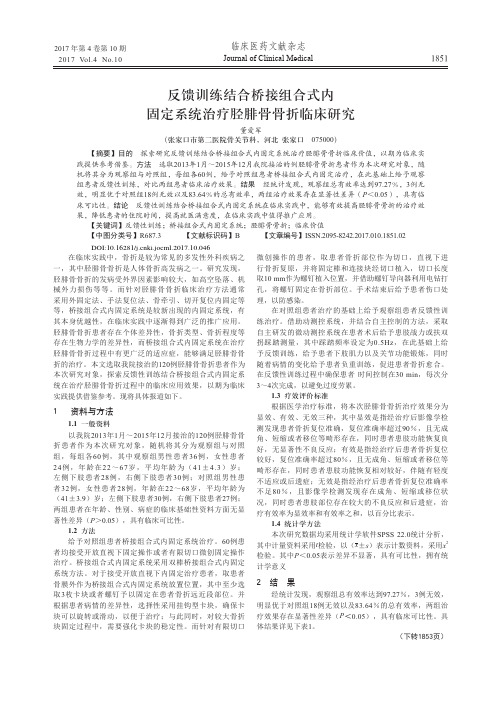
反馈训练结合桥接组合式内固定系统治疗胫腓骨骨折临床研究董爱军(张家口市第二医院骨关节科,河北张家口 075000)【摘要】目的 探索研究反馈训练结合桥接组合式内固定系统治疗胫腓骨骨折临床价值,以期为临床实践提供参考借鉴。
方法 选取2013年1月~2015年12月我院接治的例胫腓骨骨折患者作为本次研究对象,随机将其分为观察组与对照组,每组各60例,给予对照组患者桥接组合式内固定治疗,在此基础上给予观察组患者反馈性训练,对比两组患者临床治疗效果。
结果 经统计发现,观察组总有效率达到97.27%,3例无效,明显优于对照组18例无效以及83.64%的总有效率,两组治疗效果存在显著性差异(P<0.05),具有临床可比性。
结论 反馈性训练结合桥接组合式内固定系统在临床实践中,能够有效提高胫腓骨骨折的治疗效果,降低患者的住院时间,提高就医满意度,在临床实践中值得推广应用。
【关键词】反馈性训练;桥接组合式内固定系统;胫腓骨骨折;临床价值【中图分类号】R687.3 【文献标识码】B 【文章编号】ISSN.2095-8242.2017.010.1851.02在临床实践中,骨折是较为常见的多发性外科疾病之一,其中胫腓骨骨折是人体骨折高发病之一。
研究发现,胫腓骨骨折的发病受外界因素影响较大,如高空坠落、机械外力损伤等等。
而针对胫腓骨骨折临床治疗方法通常采用外固定法、手法复位法、骨牵引、切开复位内固定等等,桥接组合式内固定系统是较新出现的内固定系统,有其本身优越性,在临床实践中逐渐得到广泛的推广应用。
胫腓骨骨折患者存在个体差异性,骨折类型、骨折程度等存在生物力学的差异性,而桥接组合式内固定系统在治疗胫腓骨骨折过程中有更广泛的适应症,能够满足胫腓骨骨折的治疗。
本文选取我院接治的120例胫腓骨骨折患者作为本次研究对象,探索反馈性训练结合桥接组合式内固定系统在治疗胫腓骨骨折过程中的临床应用效果,以期为临床实践提供借鉴参考。
现将具体报道如下。
桥接组合式内固定治疗股骨骨折的效果及生物力学特征
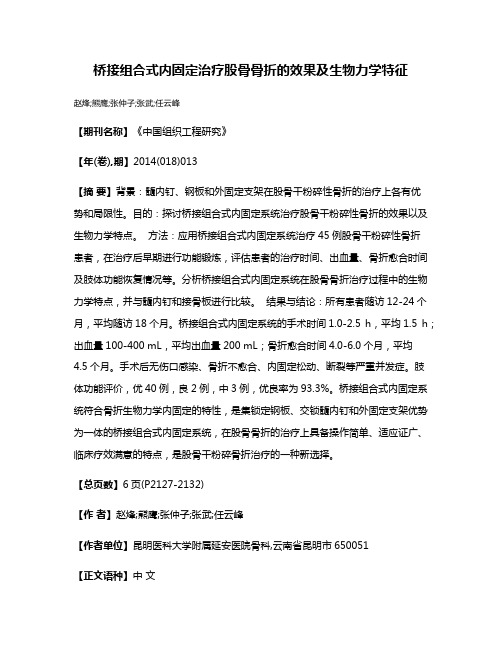
桥接组合式内固定治疗股骨骨折的效果及生物力学特征赵烽;熊鹰;张仲子;张武;任云峰【期刊名称】《中国组织工程研究》【年(卷),期】2014(018)013【摘要】背景:髓内钉、钢板和外固定支架在股骨干粉碎性骨折的治疗上各有优势和局限性。
目的:探讨桥接组合式内固定系统治疗股骨干粉碎性骨折的效果以及生物力学特点。
方法:应用桥接组合式内固定系统治疗45例股骨干粉碎性骨折患者,在治疗后早期进行功能锻炼,评估患者的治疗时间、出血量、骨折愈合时间及肢体功能恢复情况等。
分析桥接组合式内固定系统在股骨骨折治疗过程中的生物力学特点,并与髓内钉和接骨板进行比较。
结果与结论:所有患者随访12-24个月,平均随访18个月。
桥接组合式内固定系统的手术时间1.0-2.5 h,平均1.5 h;出血量100-400 mL,平均出血量200 mL;骨折愈合时间4.0-6.0个月,平均4.5个月。
手术后无伤口感染、骨折不愈合、内固定松动、断裂等严重并发症。
肢体功能评价,优40例,良2例,中3例,优良率为93.3%。
桥接组合式内固定系统符合骨折生物力学内固定的特性,是集锁定钢板、交锁髓内钉和外固定支架优势为一体的桥接组合式内固定系统,在股骨骨折的治疗上具备操作简单、适应证广、临床疗效满意的特点,是股骨干粉碎骨折治疗的一种新选择。
【总页数】6页(P2127-2132)【作者】赵烽;熊鹰;张仲子;张武;任云峰【作者单位】昆明医科大学附属延安医院骨科,云南省昆明市650051【正文语种】中文【中图分类】R318【相关文献】1.桥接组合式内固定系统治疗股骨骨折内固定术后再骨折 [J], 孙志波;杨述华;禹志宏;曾洪;李相伟;江剑2.桥接组合式内固定系统在老年股骨骨折中的应用 [J], 程兆佳;廖忠林;张学来;赵为夏;曾志军3.桥接组合式内固定治疗股骨骨折术后护理体会 [J], 王璞;金艳4.桥接组合式内固定治疗股骨骨折的效果及生物力学特征 [J], 赵烽;熊鹰;张仲子;张武;任云峰5.桥接组合式内固定系统治疗复杂股骨骨折 [J], 孙球;熊雪梅;诸葛天瑜;方苏亭;汤志刚因版权原因,仅展示原文概要,查看原文内容请购买。
骨折的生物力学原理
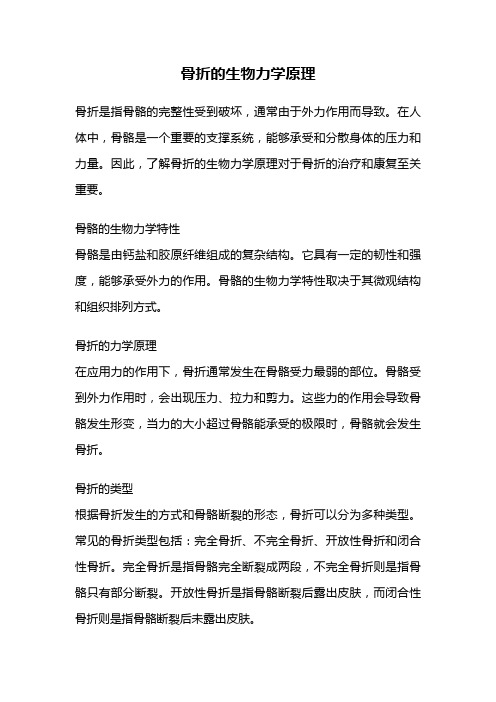
骨折的生物力学原理骨折是指骨骼的完整性受到破坏,通常由于外力作用而导致。
在人体中,骨骼是一个重要的支撑系统,能够承受和分散身体的压力和力量。
因此,了解骨折的生物力学原理对于骨折的治疗和康复至关重要。
骨骼的生物力学特性骨骼是由钙盐和胶原纤维组成的复杂结构。
它具有一定的韧性和强度,能够承受外力的作用。
骨骼的生物力学特性取决于其微观结构和组织排列方式。
骨折的力学原理在应用力的作用下,骨折通常发生在骨骼受力最弱的部位。
骨骼受到外力作用时,会出现压力、拉力和剪力。
这些力的作用会导致骨骼发生形变,当力的大小超过骨骼能承受的极限时,骨骼就会发生骨折。
骨折的类型根据骨折发生的方式和骨骼断裂的形态,骨折可以分为多种类型。
常见的骨折类型包括:完全骨折、不完全骨折、开放性骨折和闭合性骨折。
完全骨折是指骨骼完全断裂成两段,不完全骨折则是指骨骼只有部分断裂。
开放性骨折是指骨骼断裂后露出皮肤,而闭合性骨折则是指骨骼断裂后未露出皮肤。
骨折的治疗原则骨折的治疗旨在恢复骨骼的完整性和功能。
根据骨折的类型和位置,治疗方法可以包括保守治疗和手术治疗。
保守治疗主要包括骨折复位、固定和康复训练,手术治疗则是通过手术操作来恢复骨骼的完整性。
骨折的固定方法骨折的固定是指将骨骼断裂的两段牢固地连接在一起,以促进骨折的愈合。
常用的固定方法包括外固定和内固定。
外固定是通过外部装置将骨骼断裂的两段固定在一起,而内固定则是通过内部装置(如钢板、钢钉等)将骨骼断裂的两段固定在一起。
骨折的愈合过程骨折的愈合是一个复杂的生物力学过程。
在骨折发生后,通过骨骼周围的软组织形成血肉瘢痕,这是骨折愈合的第一阶段。
随后,骨骼周围的软骨组织逐渐转变为硬骨组织,形成初生骨,这是骨折愈合的第二阶段。
最后,初生骨逐渐重塑为成熟的骨组织,完成骨折的愈合。
骨折的康复训练骨折的康复训练是恢复骨骼功能和加速骨折愈合的关键。
康复训练包括功能锻炼、肌肉力量训练和平衡训练等。
通过逐渐增加运动强度和范围,可以促进骨折部位的血液循环和新陈代谢,加速骨折的愈合。
骨科生物力学

脊柱失稳是指脊柱在承受外力时发生异常位移或变形,可能导致疼痛 和功能障碍等症状。
脊柱疾病生物力学研究及治疗策略
脊柱疾病的生物力学研究
通过对脊柱疾病的生物力学研究,可以深入了解疾病的发生机制和发展过程,为制定有效 的治疗策略提供依据。
脊柱疾病的治疗策略
根据脊柱疾病的类型和严重程度,可以采取保守治疗、药物治疗、物理治疗、手术治疗等 多种治疗策略。
骨骼为人体提供支持和保护,维持身体姿势 和稳定。
造血和免疫
红骨髓具有造血功能,黄骨髓则具有免疫作 用。
运动功能
骨骼与肌肉、关节等协同作用,实现人体的 运动功能。
储存矿物质
骨骼是体内重要的矿物质储存库,尤其是钙 和磷。
骨骼损伤与修复机制
骨骼损伤类型
损伤修复过程
骨折、骨裂、骨挫伤等 是常见的骨骼损伤类型。
生物力学在治疗骨折、关节置 换、脊柱矫形等骨科手术中发 挥着重要作用,手术方案的设 计和实施需要考虑生物力学因 素,以确保手术效果和患者康 复。
在康复医学中,生物力学评估 和治疗手段可以帮助患者恢复 骨骼、肌肉和关节的正常功能 ,提高患者的生活质量。
通过对人群的生物力学指标进 行监测和评估,可以为骨科疾 病的预防提供科学依据。
纤维关节
骨性关节
由骨组织连接,如颅骨的骨连接,几 乎无活动性。
由纤维结缔组织连接,如韧带关节和 缝合关节,运动范围较小。
关节运动学与动力学分析
运动学分析
01
研究关节在三维空间中的运动轨迹、速度和加速度等,揭示关
节运动规律。
动力学分析
02
研究关节在运动过程中的力学特性和相互作用,包括力矩、功
率和能量等。
肌肉-骨骼系统分析
骨科医学中的生物力学研究
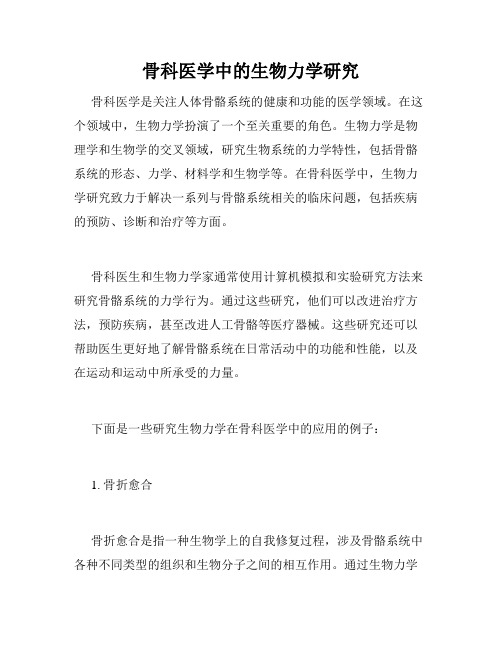
骨科医学中的生物力学研究骨科医学是关注人体骨骼系统的健康和功能的医学领域。
在这个领域中,生物力学扮演了一个至关重要的角色。
生物力学是物理学和生物学的交叉领域,研究生物系统的力学特性,包括骨骼系统的形态、力学、材料学和生物学等。
在骨科医学中,生物力学研究致力于解决一系列与骨骼系统相关的临床问题,包括疾病的预防、诊断和治疗等方面。
骨科医生和生物力学家通常使用计算机模拟和实验研究方法来研究骨骼系统的力学行为。
通过这些研究,他们可以改进治疗方法,预防疾病,甚至改进人工骨骼等医疗器械。
这些研究还可以帮助医生更好地了解骨骼系统在日常活动中的功能和性能,以及在运动和运动中所承受的力量。
下面是一些研究生物力学在骨科医学中的应用的例子:1. 骨折愈合骨折愈合是指一种生物学上的自我修复过程,涉及骨骼系统中各种不同类型的组织和生物分子之间的相互作用。
通过生物力学分析和建模,研究人员可以更好地理解骨折愈合过程中的机制,从而改进治疗策略和预防措施。
2. 骨质疏松骨质疏松是骨骼系统的一种常见问题。
它是一种骨量减少、组织低萎缩和骨密度下降的疾病,导致骨骼脆弱易碎。
通过生物力学建模,研究人员可以了解骨质疏松症下骨骼的力学性能,例如骨骼的结构和骨强度。
这些研究还可以用于改进骨质疏松预防和治疗方法的发展。
3. 人工关节和骨科植入物人工关节和其他骨科植入物是骨科医生经常使用的治疗手段。
这些植入物可以帮助骨骼系统的受损部分重获功能并减轻疼痛。
然而,不同的植入物在各种运动和负载下可能会受到不同的力学应力。
因此,生物力学建模可以用于评估不同类型的植入物在各种情况下的性能,并预测其在日常活动中的生物相容性。
综上所述,生物力学在骨科医学中的应用非常广泛,涉及多个临床问题和治疗手段。
通过这些研究,我们可以更好地理解骨骼系统的力学和生物特性,并更好地预测和治疗相关的疾病。
生物力学领域的不断发展和进步将继续帮助骨科医生改进现有的治疗方法,为全球人民提供更好的医疗服务。
股骨颈骨折内固定治疗的生物力学研究进展
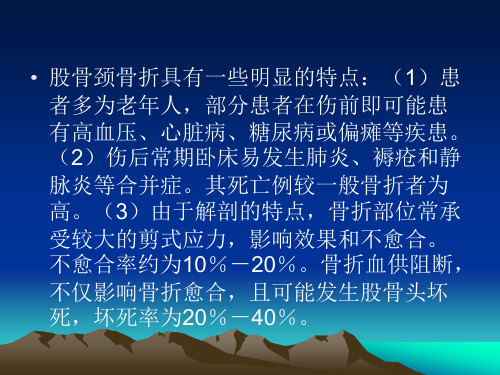
• 使用此钉固定,从生物力学角度分析,应 使之与股骨颈纵轴成20º角左右的方向,由 外下向内上紧贴着股骨距进入。这样可使 断端获得较大的压应力与较小的剪切力, 对加速愈合有利。但使用此方法,内固定 过程中需要进行锤击和大粗隆冲击,有可 能损伤股骨头血供。
• 另外,此钉无螺纹,又不能有效地抗旋转, 故载荷时易导致骨折断端的分离和影响血 供,不能有效的加压稳定作用。三翼钉固 定强度、刚度虽大,但对血运破坏严重, 应力遮挡大,影响骨折的愈合。胡清潭认 为:三翼钉击入时对周围骨质损伤大,且 两侧迅速受压缩或翼刃切割,是导致手术 后松动的根源。此外,它没有加压作用, 击入时反会造成骨折线分离,易引起骨不 连
• 股骨颈骨折是一种较难愈合的骨折,有关 其治疗还有很多工作有待研究和探索。三 针呈倒等腰三角形立体植入股骨颈内,与 股骨的主应力方向一置,在股骨颈中各起 着相同的负重作用,符合生物力学规律, 对股骨血运破坏小,为目前为止最好的固 定方法。
• 总之,重视早期复位质量,选择适当的坚 强的内固定及局部血管的早期恢复是治疗 股骨颈骨折的基本原则和要求。
• 股骨颈骨折具有一些明显的特点:(1)患 者多为老年人,部分患者在伤前即可能患 有高血压、心脏病、糖尿病或偏瘫等疾患。 (2)伤后常期卧床易发生肺炎、褥疮和静 脉炎等合并症。其死亡例较一般骨折者为 高。(3)由于解剖的特点,骨折部位常承 受较大的剪式应力,影响效果和不愈合。 不愈合率约为10%-20%。骨折血供阻断, 不仅影响骨折愈合,且可能发生股骨头坏 死,坏死率为20%-40%。
Байду номын сангаас
• 两种骨小梁系统在交叉的中心形成一个三 角形脆弱区域,称为“Ward三角”。股骨 干上端内后侧很多致密的骨小梁结合成相 当致密的一块骨板,通过小粗隆到达股骨 颈下方,为股骨距,此结构可加强干颈间 的连接与支持,从力学角度看,相当于起 重机的力臂。
桥接组合式内固定系统治疗股骨骨折内固定术后再骨折
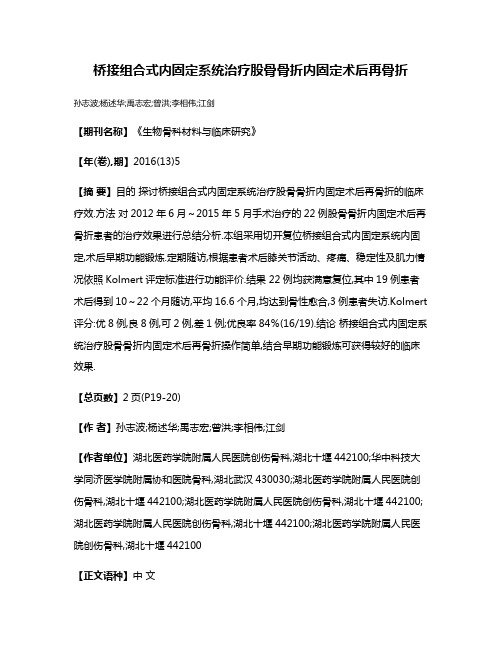
桥接组合式内固定系统治疗股骨骨折内固定术后再骨折孙志波;杨述华;禹志宏;曾洪;李相伟;江剑【期刊名称】《生物骨科材料与临床研究》【年(卷),期】2016(13)5【摘要】目的探讨桥接组合式内固定系统治疗股骨骨折内固定术后再骨折的临床疗效.方法对2012年6月~2015年5月手术治疗的22例股骨骨折内固定术后再骨折患者的治疗效果进行总结分析.本组采用切开复位桥接组合式内固定系统内固定,术后早期功能锻炼.定期随访,根据患者术后膝关节活动、疼痛、稳定性及肌力情况依照Kolmert评定标准进行功能评价.结果 22例均获满意复位,其中19例患者术后得到10~22个月随访,平均16.6个月,均达到骨性愈合,3例患者失访.Kolmert 评分:优8例,良8例,可2例,差1例;优良率84%(16/19).结论桥接组合式内固定系统治疗股骨骨折内固定术后再骨折操作简单,结合早期功能锻炼可获得较好的临床效果.【总页数】2页(P19-20)【作者】孙志波;杨述华;禹志宏;曾洪;李相伟;江剑【作者单位】湖北医药学院附属人民医院创伤骨科,湖北十堰442100;华中科技大学同济医学院附属协和医院骨科,湖北武汉430030;湖北医药学院附属人民医院创伤骨科,湖北十堰442100;湖北医药学院附属人民医院创伤骨科,湖北十堰442100;湖北医药学院附属人民医院创伤骨科,湖北十堰442100;湖北医药学院附属人民医院创伤骨科,湖北十堰442100【正文语种】中文【中图分类】R683【相关文献】1.股骨骨折内固定取出术后再骨折的治疗 [J], 鲍海星;严清2.24例股骨骨折内固定术后再骨折的成因与治疗 [J], 王长伟;王文礼;廖光禄3.带锁髓内钉治疗股骨骨折术后再骨折原因分析(附2例报告) [J], 修光文4.带锁髓内钉在股骨骨折术后内固定失效及再骨折中的应用 [J], 陈夏平;郭伟煌;刘志强5.桥接组合式内固定系统治疗复杂股骨骨折 [J], 孙球;熊雪梅;诸葛天瑜;方苏亭;汤志刚因版权原因,仅展示原文概要,查看原文内容请购买。
桥接组合式内固定系统手术治疗复杂四肢骨折的效果观察
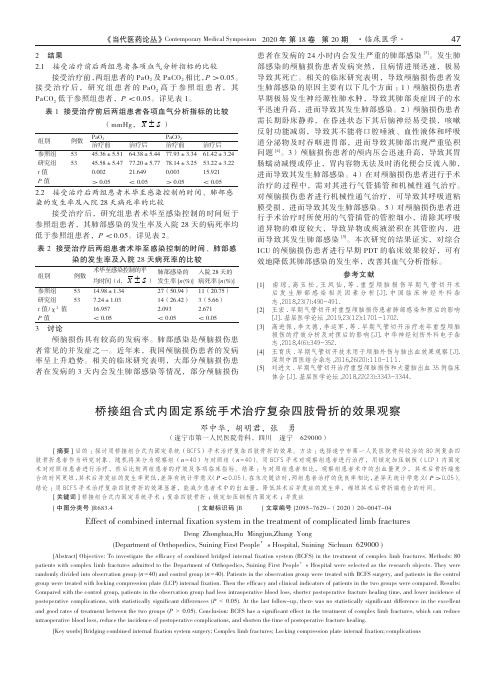
桥接组合式内固定系统手术治疗复杂四肢骨折的效果观察邓中华,胡明君,张 勇(遂宁市第一人民医院骨科,四川 遂宁 629000)[摘要]目的:探讨用桥接组合式内固定系统(BCFS)手术治疗复杂四肢骨折的效果。
方法:选择遂宁市第一人民医院骨科收治的80例复杂四肢骨折患者作为研究对象。
随机将其分为观察组(n=40)与对照组(n=40)。
用BCFS 手术对观察组患者进行治疗,用锁定加压钢板(LCP)内固定术对对照组患者进行治疗,然后比较两组患者的疗效及各项临床指标。
结果:与对照组患者相比,观察组患者术中的出血量更少,其术后骨折端愈合的时间更短,其术后并发症的发生率更低,差异有统计学意义(P <0.05)。
在末次随访时,两组患者治疗的优良率相比,差异无统计学意义(P >0.05)。
结论:用BCFS 手术治疗复杂四肢骨折的效果显著,能减少患者术中的出血量,降低其术后并发症的发生率,缩短其术后骨折端愈合的时间。
[关键词]桥接组合式内固定系统手术;复杂四肢骨折;锁定加压钢板内固定术;并发症[中图分类号]R683.4 [文献标识码]B [文章编号]2095-7629-(2020)20-0047-04Effect of combined internal fixation system in the treatment of complicated limb fracturesDeng Zhonghua,Hu Mingjun,Zhang Yong(Department of Orthopedics, Suining First People’s Hospital, Suining Sichuan 629000 )[Abstract] Objective: To investigate the efficacy of combined bridged internal fixation system (BCFS) in the treatment of complex limb fractures. Methods: 80 patients with complex limb fractures admitted to the Department of Orthopedics, Suining First People’s Hospital were selected as the research objects. They were randomly divided into observation group (n=40) and control group (n=40). Patients in the observation group were treated with BCFS surgery, and patients in the control group were treated with locking compression plate (LCP) internal fixation. Then the efficacy and clinical indicators of patients in the two groups were compared. Results: Compared with the control group, patients in the observation group had less intraoperative blood loss, shorter postoperative fracture healing time, and lower incidence of postoperative complications, with statistically significant differences (P < 0.05). At the last follow-up, there was no statistically significant difference in the excellent and good rates of treatment between the two groups (P > 0.05). Conclusion: BCFS has a significant effect in the treatment of complex limb fractures, which can reduce intraoperative blood loss, reduce the incidence of postoperative complications, and shorten the time of postoperative fracture healing.[Key words] Bridging combined internal fixation system surgery; Complex limb fractures; Locking compression plate internal fixation; complications2 结果2.1 接受治疗前后两组患者各项血气分析指标的比较接受治疗前,两组患者的PaO 2及PaCO 2相比,P >0.05。
骨科生物力学

抗张性
骨骼能够抵抗拉伸和扭曲 力,保持身体的完整性和 运动能力。
弹性
骨骼具有一定的弹性,能 够在一定程度上吸收和分 散外力,减少损伤。
骨骼的生物力学模型
有限元分析
通过将骨骼划分为有限个元素,并分 析这些元素在各种外力作用下的反应, 可以预测骨骼在各种情况下的行为。
生物力学实验
数值模拟
利用计算机技术模拟骨骼在各种外力 作用下的行为,可以预测骨骼在不同 情况下的响应,为骨科疾病的诊断和 治疗提供依据。
通过实验方法测量骨骼在不同外力作 用下的响应,可以了解骨骼的实际生 物力学特性。
03
关节的生物力学特性
关节的结构与功能
总结词
关节的结构与功能是相互关联的,其结构决定了其功能,而功能的需求又会影 响其结构的发展。
详细描述
关节的结构复杂,包括骨骼、软骨、韧带、肌肉等组织,这些组织协同工作, 使关节能够进行各种运动。关节的功能主要包括运动、支撑和缓冲等。
运动医学
骨科生物力学在运动医学领域的应用主要涉及运动损伤的 预防和治疗,如肌肉拉伤、韧带撕裂、骨折等。
康复工程
在康复工程中,骨科生物力学可以帮助设计康复训练设备 ,制定康复治疗方案,提高康复效果。
骨关节炎治疗
骨科生物力学可以帮助理解骨关节炎的发病机制,为骨关 节炎的治疗提供理论支持和实践指导。
骨科生物力学的发展历程
位。
应力分散
内固定物应能够分散骨折部位的应 力,降低局部应力集中,减少骨折 端的活动。
材料选择
内固定物的材料应具备足够的强度 和耐久性,能够承受骨折愈合过程 中的生理应力。
外固定物的生物力学原理
稳定性
外固定物应提供足够的稳定性, 保持骨折部位的固定和位置。
桥接组合式内固定系统治疗股骨干骨折术后骨不连的临床效果
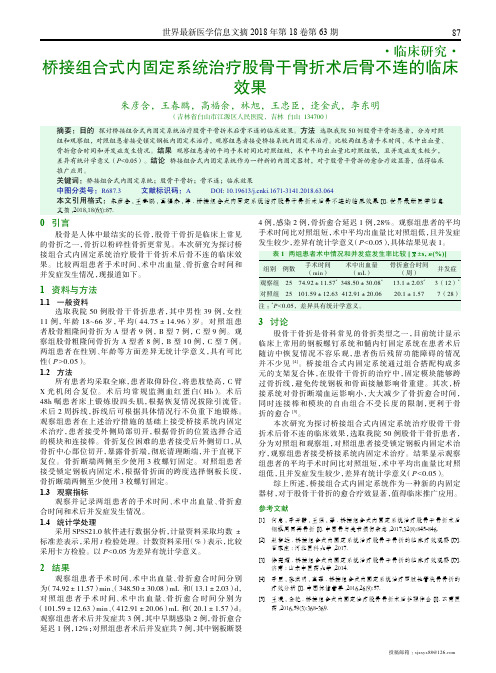
世界最新医学信息文摘 2018年第18卷第63期 87·临床研究·0 引言股骨是人体中最结实的长骨,股骨干骨折是临床上常见的骨折之一,骨折以粉碎性骨折更常见。
本次研究为探讨桥接组合式内固定系统治疗股骨干骨折术后骨不连的临床效果。
比较两组患者手术时间、术中出血量、骨折愈合时间和并发症发生情况,现报道如下。
1 资料与方法1.1一般资料选取我院50例股骨干骨折患者,其中男性39例,女性11例,年龄18~66岁,平均(44.75±14.96)岁。
对照组患者股骨粗隆间骨折为A型者9例,B型7例,C型9例。
观察组股骨粗隆间骨折为A型者8例,B型10例,C型7例。
两组患者在性别、年龄等方面差异无统计学意义,具有可比性(P>0.05)。
1.2方法所有患者均采取全麻,患者取仰卧位,将患肢垫高,C臂X光机闭合复位。
术后均常规监测血红蛋白(Hb)。
术后48h嘱患者床上锻炼股四头肌,根据恢复情况拔除引流管。
术后2周拆线,拆线后可根据具体情况行不负重下地锻炼。
观察组患者在上述治疗措施的基础上接受桥接系统内固定术治疗,患者接受外侧局部切开,根据骨折的位置选择合适的模块和连接棒。
骨折复位困难的患者接受后外侧切口,从骨折中心部位切开,暴露骨折端,彻底清理断端,并于直视下复位。
骨折断端两侧至少使用3枚螺钉固定。
对照组患者接受锁定钢板内固定术,根据骨折面的跨度选择钢板长度,骨折断端两侧至少使用3枚螺钉固定。
1.3观察指标观察并记录两组患者的手术时间、术中出血量、骨折愈合时间和术后并发症发生情况。
1.4统计学处理采用SPSS21.0软件进行数据分析,计量资料采取均数±标准差表示,采用t检验处理。
计数资料采用(%)表示,比较采用卡方检验。
以P<0.05为差异有统计学意义。
2 结果观察组患者手术时间、术中出血量、骨折愈合时间分别为(74.92±11.57)min、(348.50±30.08)mL和(13.1±2.03)d,对照组患者手术时间、术中出血量、骨折愈合时间分别为(101.59±12.63)min、(412.91±20.06)mL和(20.1±1.57)d。
桥接组合式内固定系统和锁定钢板系统治疗股骨干骨折的疗效比较
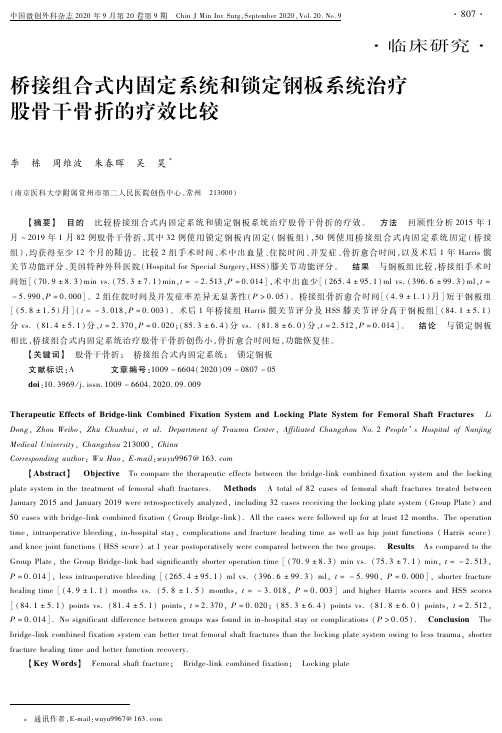
·临床研究·桥接组合式内固定系统和锁定钢板系统治疗股骨干骨折的疗效比较李 栋 周维波 朱春晖 吴 昊(南京医科大学附属常州市第二人民医院创伤中心,常州 213000) 【摘要】 目的 比较桥接组合式内固定系统和锁定钢板系统治疗股骨干骨折的疗效。
方法 回顾性分析2015年1月~2019年1月82例股骨干骨折,其中32例使用锁定钢板内固定(钢板组),50例使用桥接组合式内固定系统固定(桥接组),均获得至少12个月的随访。
比较2组手术时间、术中出血量、住院时间、并发症、骨折愈合时间,以及术后1年Harris髋关节功能评分、美国特种外科医院(HospitalforSpecialSurgery,HSS)膝关节功能评分。
结果 与钢板组比较,桥接组手术时间短[(70.9±8.3)minvs.(75.3±7.1)min,t=-2.513,P=0.014],术中出血少[(265.4±95.1)mlvs.(396.6±99.3)ml,t=-5.990,P=0.000]。
2组住院时间及并发症率差异无显著性(P>0.05)。
桥接组骨折愈合时间[(4.9±1 1)月]短于钢板组[(5.8±1.5)月](t=-3.018,P=0.003)。
术后1年桥接组Harris髋关节评分及HSS膝关节评分高于钢板组[(84.1±5.1)分vs.(81.4±5.1)分,t=2.370,P=0.020;(85.3±6.4)分vs.(81.8±6.0)分,t=2.512,P=0.014]。
结论 与锁定钢板相比,桥接组合式内固定系统治疗股骨干骨折创伤小,骨折愈合时间短,功能恢复佳。
【关键词】 股骨干骨折; 桥接组合式内固定系统; 锁定钢板文献标识:A 文章编号:1009-6604(2020)09-0807-05doi:10.3969/j.issn.1009-6604.2020.09.009TherapeuticEffectsofBridge linkCombinedFixationSystemandLockingPlateSystemforFemoralShaftFractures LiDong,ZhouWeibo,ZhuChunhui,etal.DepartmentofTraumaCenter,AffiliatedChangzhouNo.2People’sHospitalofNanjingMedicalUniversity,Changzhou213000,ChinaCorrespondingauthor:WuHao,E mail:wuyu9967@163.com【Abstract】 Objective Tocomparethetherapeuticeffectsbetweenthebridge linkcombinedfixationsystemandthelockingplatesysteminthetreatmentoffemoralshaftfractures. Methods Atotalof82casesoffemoralshaftfracturestreatedbetweenJanuary2015andJanuary2019wereretrospectivelyanalyzed,including32casesreceivingthelockingplatesystem(GroupPlate)and50caseswithbridge linkcombinedfixation(GroupBridge link).Allthecaseswerefollowedupforatleast12months.Theoperationtime,intraoperativebleeding,in hospitalstay,complicationsandfracturehealingtimeaswellashipjointfunctions(Harrisscore)andkneejointfunctions(HSSscore)at1yearpostoperativelywerecomparedbetweenthetwogroups. Results AscomparedtotheGroupPlate,theGroupBridge linkhadsignificantlyshorteroperationtime[(70.9±8.3)minvs.(75.3±7.1)min,t=-2.513,P=0.014],lessintraoperativebleeding[(265.4±95.1)mlvs.(396.6±99.3)ml,t=-5.990,P=0.000],shorterfracturehealingtime[(4.9±1.1)monthsvs.(5.8±1.5)months,t=-3.018,P=0.003]andhigherHarrisscoresandHSSscores[(84.1±5.1)pointsvs.(81.4±5.1)points,t=2.370,P=0.020;(85.3±6.4)pointsvs.(81.8±6.0)points,t=2.512,P=0.014].Nosignificantdifferencebetweengroupswasfoundinin hospitalstayorcomplications(P>0.05). Conclusion Thebridge linkcombinedfixationsystemcanbettertreatfemoralshaftfracturesthanthelockingplatesystemowingtolesstrauma,shorterfracturehealingtimeandbetterfunctionrecovery.【KeyWords】 Femoralshaftfracture; Bridge linkcombinedfixation; Lockingplate·708·中国微创外科杂志2020年9月第20卷第9期 ChinJMinInvSurg,September2020,Vol.20.No.9通讯作者,E mail:wuyu9967@163.com 股骨干骨折一般是由直接或间接暴力冲击所致,青壮年是主要患病群体[1]。
骨伤科生物力学

骨伤科生物力学骨伤科生物力学是研究人体骨骼系统在运动中的力学特性和力学变化规律的学科。
它结合了生物学和力学的原理,通过研究骨骼系统的力学行为,可以帮助医生更好地理解和治疗骨伤疾病。
一、骨骼系统的力学特性骨骼系统是人体的支撑结构,能够承受来自外部的力和负载。
骨骼系统的力学特性包括骨骼的刚度、强度和韧性。
1. 刚度:骨骼的刚度是指骨骼对外部力的抵抗能力。
刚度越大,骨骼对外力的变形程度越小。
骨骼的刚度主要由骨组织的弹性模量决定,不同骨骼部位的刚度也不同。
2. 强度:骨骼的强度是指骨骼能够承受的最大力。
强度与骨骼的结构和组织密切相关,骨骼中的骨小梁和骨小片是承受压力和拉力的主要部位,它们的数量和分布对骨骼的强度起着重要作用。
3. 韧性:骨骼的韧性是指骨骼对外部冲击或震动的抵抗能力。
韧性主要由骨骼的韧带和骨骼间负责缓冲和吸收冲击力的软骨组织共同作用。
二、生物力学在骨伤科中的应用生物力学研究的目标是通过分析骨骼系统的力学行为,为骨伤科的临床实践提供理论依据和技术支持。
1. 骨折修复:生物力学可以帮助医生了解骨折过程中骨骼的应力和应变变化,通过设计适当的外固定装置或内固定器材来促进骨折的愈合。
此外,生物力学还可以评估不同修复方法的效果,并优化治疗方案。
2. 关节置换:生物力学可以评估关节置换术的效果和潜在的机械问题,为手术方案的选择和术后康复提供指导。
通过模拟和分析关节的力学行为,可以预测人工关节的寿命和功能,进一步优化关节置换手术的效果。
3. 运动损伤预防:生物力学可以分析运动时骨骼系统的负荷分布和运动方式,帮助预防运动损伤的发生。
通过评估运动员的运动技术和姿势,可以提出相应的建议和指导,减少运动伤害的风险。
4. 功能评估和康复训练:生物力学可以通过运动分析和力学测量来评估患者的骨骼功能,并设计个性化的康复训练方案。
通过监测康复过程中的力学变化,可以及时调整康复计划,提高康复效果。
三、发展趋势和挑战随着科技的进步和研究的深入,骨伤科生物力学面临着新的机遇和挑战。
桥接组合式内固定系统在肱骨及胫骨骨折中的应用分析

桥接组合式内固定系统在肱骨及胫骨骨折中的应用分析作者:刁天华郑志远李涛来源:《中国医药科学》2014年第02期[摘要] 目的探讨桥接组合式内固定系统治疗肱骨及胫骨骨折的有效性和安全性。
方法回顾性分析我院2013年1~10月收治的16例肱骨及胫骨骨折患者的临床资料,所有患者均使用桥接组合式内固定系统进行治疗,术后定期复查X线片,将患侧同健侧对比,通过患肢成角、旋转及短缩情况评价临床疗效。
结果所有患者均手术成功,无一例死亡。
术后均无伤口感染、内固定金属松动、断裂和骨折不愈合等严重并发症发生;优良率为93.8%(15/16)。
结论桥接组合式内固定系统的结构设计合理,生物学和生物力学特性均符合骨科发展的BO原则,可有效避免应力遮挡、集中及金属断裂等问题,有利于骨折愈合。
[关键词] 桥接组合式内固定;肱骨;胫骨;骨折[中图分类号] R683.4 [文献标识码] B [文章编号] 2095-0616(2014)02-168-03长管状骨高能量损伤的发病率逐年升高,钢板、髓内钉及外固定支架是临床治疗的常用方法,但存在着应力遮挡、应力集中和并发症较多等缺点[1]。
本研究回顾性分析我院收治的16例肱骨及胫骨骨折患者的临床资料,旨在探讨桥接组合式内固定系统治疗肱骨及胫骨骨折的有效性和安全性。
现将研究结果报道如下。
1 资料与方法1.1 一般资料回顾性分析我院2013年1~10月收治的16例肱骨及胫骨骨折患者的临床资料,所有患者均经过X线检查确诊。
男11例,女5例,年龄22~75岁,平均(45.5±5.4)岁,病程1~9d,平均(7.2±1.5)d;致伤原因:交通事故伤6例,高处坠落伤3例,重物砸伤4例,摔伤3例;肱骨骨折6例,其中骨不连1例,邻近关节骨折2例,合并桡神经损伤2例;胫骨骨折10例,其中骨不连2例,邻近关节骨折5例,Ⅰ度开放骨折2例,合并腓骨骨折6例。
1.2 方法所有患者均积极完善术前准备,入手术室后监测生命体征,行全麻气管内插管。
桥接组合式内固定系统与锁定钢板治疗锁骨中段骨折的疗效比较
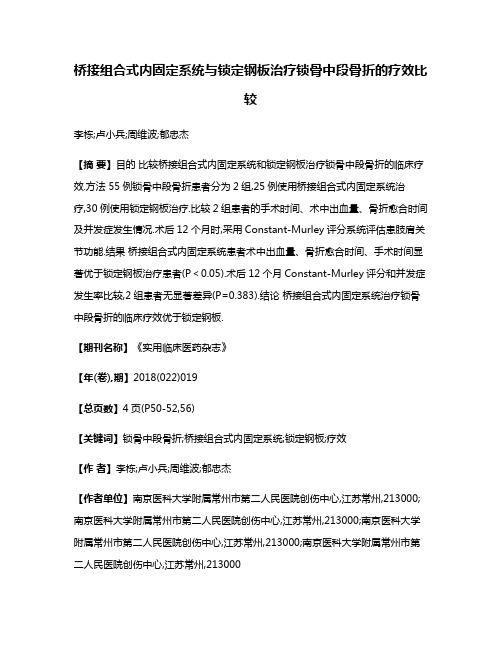
桥接组合式内固定系统与锁定钢板治疗锁骨中段骨折的疗效比较李栋;卢小兵;周维波;郁忠杰【摘要】目的比较桥接组合式内固定系统和锁定钢板治疗锁骨中段骨折的临床疗效.方法 55例锁骨中段骨折患者分为2组,25例使用桥接组合式内固定系统治疗,30例使用锁定钢板治疗.比较2组患者的手术时间、术中出血量、骨折愈合时间及并发症发生情况.术后12个月时,采用Constant-Murley评分系统评估患肢肩关节功能.结果桥接组合式内固定系统患者术中出血量、骨折愈合时间、手术时间显著优于锁定钢板治疗患者(P<0.05).术后12个月Constant-Murley评分和并发症发生率比较,2组患者无显著差异(P=0.383).结论桥接组合式内固定系统治疗锁骨中段骨折的临床疗效优于锁定钢板.【期刊名称】《实用临床医药杂志》【年(卷),期】2018(022)019【总页数】4页(P50-52,56)【关键词】锁骨中段骨折;桥接组合式内固定系统;锁定钢板;疗效【作者】李栋;卢小兵;周维波;郁忠杰【作者单位】南京医科大学附属常州市第二人民医院创伤中心,江苏常州,213000;南京医科大学附属常州市第二人民医院创伤中心,江苏常州,213000;南京医科大学附属常州市第二人民医院创伤中心,江苏常州,213000;南京医科大学附属常州市第二人民医院创伤中心,江苏常州,213000【正文语种】中文【中图分类】R683锁骨中段多为圆柱状,直径较小,肌肉、韧带附着少,是力学薄弱部位,因此锁骨中段骨折发生率最高,约占全部锁骨骨折的80%[1-3]。
手术治疗对于患者早期功能锻炼、维持肩关节的功能起着重要的作用[4]。
目前,接骨板固定是最主要的内固定方式[5], 但术中骨折端骨膜的过分剥离容易造成锁骨不愈合、延迟愈合,且接骨板钉孔部位形成薄弱区,容易引起钢板的断裂[6]。
桥接组合式固定系统是一种新的固定材料,其具有较好的生物力学特点,具有多棒和转向置钉方式的优势,能够进行三维固定,减少应力不集中等不良情况的出现[7]。
生物力学在骨科治疗中的应用

生物力学在骨科治疗中的应用骨科治疗一直是医学领域中的重要分支之一,它涉及到骨骼系统的各种问题的治疗,包括但不限于骨纹理分析、骨折愈合、植入物设计、人工关节置换等。
而生物力学的应用在骨科医学中已有着广泛的应用。
生物力学是一门科学研究单位运动、保持平衡、受力及其变形、摩擦等方面的学科,从而对生命体进行运动学和功能模拟等的研究。
通过生物力学分析骨骼系统的各种参数,医生可以更好地评估患者的病情,为治疗提供更好的方式和手段。
生物力学分析骨骼系统在骨科治疗中,生物力学可以用来分析骨骼系统在受力和运动方面的参数。
通过对这些参数的检测、分析和评估,骨科医生可以更透彻地了解病人的病情,从而有针对性地应用治疗手段。
首先,生物力学可以测量骨骼系统中的压力和强度等参数。
通过骨骼系统的压力分析,医生可以了解骨骼是否处于合适的重力状态下,以及骨骼受力情况是否过大,进而判断骨骼系统的健康状况。
另外,生物力学还可以测量骨骼系统中的强度参数,评估骨骼的承受能力和负荷承受极限,从而更好地做出治疗决策。
其次,生物力学还可以分析骨折愈合的过程。
骨折后经过固定以及一定时间的恢复,骨折部位的骨头需要恢复正常的强度和功能。
生物力学可以通过检测骨折部位的变形、拐弯等变化,帮助医生判断骨折是否恢复,并在治疗中给出更好的建议。
最后,生物力学还可以用于植入物的设计和应用。
人工植入物常用于骨科医学中,如人工髋关节、人工脊柱椎体等。
医生们可以利用生物力学将设计出的人工植入物应用到合适的位置,以达到恢复患者正常身体功能的目的。
生物力学的应用案例生物力学在骨科治疗中的应用已有很多成功案例。
以下仅列举其中的几个。
首先,生物力学可以通过评估骨骼的压力分布来判断骨骼系统的健康情况。
近年来,越来越多的医生开始采用计算机模拟技术辅助骨科医学的研究,生物力学是其中重要的组成部分。
研究表明,生物力学分析在对骨折类型和愈合情况判断、植入物设计和优化以及关节置换等方面都具有一定的应用价值。
2种构型2枚I.CO.S.固定股骨颈骨折的生物力学比较
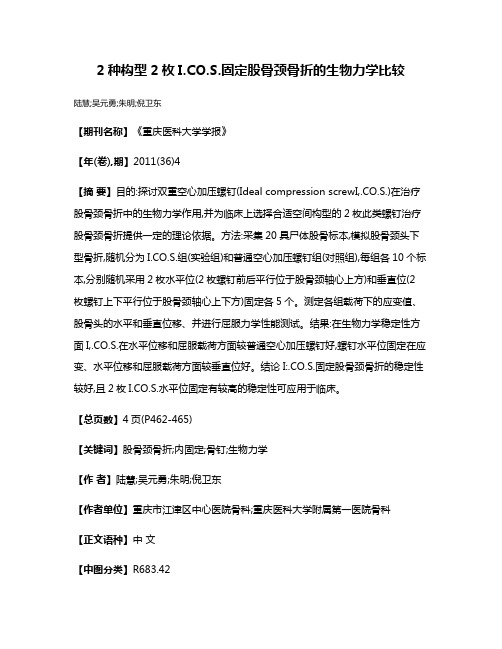
2种构型2枚I.CO.S.固定股骨颈骨折的生物力学比较陆慧;吴元勇;朱明;倪卫东【期刊名称】《重庆医科大学学报》【年(卷),期】2011(36)4【摘要】目的:探讨双重空心加压螺钉(Ideal compression screwI,.CO.S.)在治疗股骨颈骨折中的生物力学作用,并为临床上选择合适空间构型的2枚此类螺钉治疗股骨颈骨折提供一定的理论依据。
方法:采集20具尸体股骨标本,模拟股骨颈头下型骨折,随机分为I.CO.S.组(实验组)和普通空心加压螺钉组(对照组),每组各10个标本,分别随机采用2枚水平位(2枚螺钉前后平行位于股骨颈轴心上方)和垂直位(2枚螺钉上下平行位于股骨颈轴心上下方)固定各5个。
测定各组载荷下的应变值、股骨头的水平和垂直位移、并进行屈服力学性能测试。
结果:在生物力学稳定性方面I,.CO.S.在水平位移和屈服载荷方面较普通空心加压螺钉好,螺钉水平位固定在应变、水平位移和屈服载荷方面较垂直位好。
结论I:.CO.S.固定股骨颈骨折的稳定性较好,且2枚I.CO.S.水平位固定有较高的稳定性可应用于临床。
【总页数】4页(P462-465)【关键词】股骨颈骨折;内固定;骨钉;生物力学【作者】陆慧;吴元勇;朱明;倪卫东【作者单位】重庆市江津区中心医院骨科;重庆医科大学附属第一医院骨科【正文语种】中文【中图分类】R683.42【相关文献】1.两种构型三枚螺钉固定股骨颈骨折的生物力学比较 [J], 史威;张英泽;贾卫斗;李素红2.Pauwels Ⅲ型股骨颈骨折:平行与交叉构型螺钉固定的生物力学研究 [J], 刘阳;周力;陶剑锋;李慧;王满宜3.两种构型空心加压螺钉固定头颈型股骨颈骨折的生物力学特征 [J], 史威;范婕;张英泽;杨搏贵;贾卫斗;李素红4.新构型四枚空心钉固定极不稳定型股骨颈骨折生物力学分析 [J], 林焱斌;余光书;钟志辉;沈兆庆;郑伟;庄研;许阳凯5.菱形构型空心钉固定Pauwels Ⅲ型股骨颈骨折生物力学特性的有限元分析 [J], 陈宇峰;任栋;耿林丹;张国琛;宋朝晖;吴昊天;姚双权;王鹏程因版权原因,仅展示原文概要,查看原文内容请购买。
- 1、下载文档前请自行甄别文档内容的完整性,平台不提供额外的编辑、内容补充、找答案等附加服务。
- 2、"仅部分预览"的文档,不可在线预览部分如存在完整性等问题,可反馈申请退款(可完整预览的文档不适用该条件!)。
- 3、如文档侵犯您的权益,请联系客服反馈,我们会尽快为您处理(人工客服工作时间:9:00-18:30)。
桥接系统混棒与双棒结构治疗股骨及胫骨骨折的生物力学特点
·研究原著·
汪 亮1,黄朝朝2,于娇娜2,顾卫东1,王 忍1,钱志艺1 (1常州市第七人民医院骨科,江苏省常州市
有限公司牛顿实验室,天津市 301600)
摘要 背景:桥接系统双棒结构为偏心固定,术后可能导致纵向上固定减弱及横向上抗扭转降低。 目的:比较桥接组合式内固定系统混棒与双棒结构治疗股骨及胫骨骨折的生物力学特性。 方法:以 40 根短聚甲醛材料配对模拟人体长骨骨干模型 20 个,其中 10 个以桥接组合式内固定系统混棒结 构固定(混棒结构组),另 10 个以桥接组合式内固定系统双棒结构固定(双棒结构组),对 2 组分别进行轴向压 缩实验和径向扭转实验(每种实验各选择每组 5 个模型),观察 2 组的轴向压缩力与位移情况,以及横向扭转 力与角度变化,记录各组曲线出现折点或趋于水平状态时的载荷即最大载荷,并计算屈服载荷。 结果与结论:①当轴向压缩屈服载荷≤2 000 N、产生相同位移时,混棒结构组所需轴向压缩屈服载荷大于 双棒结构组;当轴向压缩屈服载荷>2 000 N、产生相同位移时,双棒结构组所需轴向压缩屈服载荷大于混 棒结构组,并且双棒结构组最大轴向压缩屈服载荷大于混棒结构组[(2 420.60±5.67),(2 721.40±5.80)N, t=-82.885,P=0];②当径向扭转屈服载荷≤50 N•m、产生相同角度时,混棒结构组所需的扭矩小于双棒结 构组;当径向扭转屈服载荷>50 N•m、产生相同角度时,混棒结构组所需扭矩大于双棒结构组,并且混棒结 构组最大径向扭转屈服载荷大于双棒结构组 [(101.85±2.97),(85.41±2.82)N•m,t=8.985,P=0];③结果说 明,桥接系统混棒与双棒结构纵向上均可坚强固定骨折,但混棒结构固定骨折更稳定、牢靠,更容易促使骨 折愈合;混棒结构横向上固定骨折后,骨折端容易产生微动,符合弹性固定,并且最大抗扭转力及抗疲劳性 能优于双棒结构,可防止因横向不稳定造成的桥接系统断裂。 关键词: 桥接组合式内固定系统;双棒结构;混棒结构;生物力学;股骨与胫骨骨折;屈服载荷;轴向压缩 中图分类号:R459.9;R318.01;R-331 基金资助: 国家卫计委科技发展中心项目《桥接系统治疗四肢及骨盆骨折的临床研究》(W2015QJ045),项目负责人: 顾卫东
Wang Liang1, Huang Zhaozhao2, Yu Jiaona2, Gu Weidong1, Wang Ren1, Qian Zhiyi1 (1Department of Orthopedics, the Seventh People's Hospital of Changzhou, Changzhou 213011, Jiangsu Province, China; 2Newton Laboratory, Tianjin Weiman Biomaterials Co., Ltd., Tianjin
Biomechanical characteristics of bridge-link type combined internal fixation system with mixed-rod versus double-rod in the treatment of femoral and tibial fractures
汪亮,男,1986 年生,安 徽省铜陵市人,汉族,2016 年安徽医科大学毕业,硕 士,医师,主要从事四肢 及骨盆骨折方面的研究。
通讯作者:顾卫东,主任 医师,常州市第七人民医 院骨科,江苏省常州市 213011
文献标识码:B 投稿日期:2018-11-01 送审日期:2018-11-10 采用日期:2018-12-08 在线日期:2019-03-05
(1)轴向压缩力与位移情况; (2)横向扭转力与角度变化; (3)记录各组曲线出现折点或趋
于水平状态时的载荷即最大
载荷,计算屈服载荷。
结局意义:
(1)桥接系统混棒与双折更稳定、牢靠,更 容易促使骨折愈合;
(2)混棒结构骨折固定后,横向上骨折端容易产生微动,符合弹性固定,且抗疲劳性能优于双棒 结构。
DOI:10.3969/j.issn.2095-4344.1189
ORCID: 0000-0002-0608-5303(汪亮)
213011;2天津市威曼生物材料
文章快速阅读:
文章特点— (1)桥接组合式内固定系统采用双棒固定骨折时,由于双棒结构为偏心固定,可能导致纵向上固定减
弱及横向上抗扭转降低; (2)采用桥接组合式内固定系统固定骨折,比较混棒结构与双棒结构固定的生物力学差异。
Wang Liang, Master, Physician, Department of Orthopedics, the Seventh People's Hospital of Changzhou, Changzhou 213011, Jiangsu Province, China
Corresponding author: Gu Weidong, Chief physician, Department of Orthopedics, the Seventh People's Hospital of Changzhou, Changzhou 213011, Jiangsu Province, China
文题释义: 桥接系统双棒与混棒结构:桥接系统双棒结构类似于锁定钢板,固定骨折方式为平行一侧骨面的偏心固定, 但偏心固定可能导致纵向上固定减弱及横向上抗扭转降低,骨折端固定不牢靠而使骨折不易愈合,甚至内固 定疲劳失效。桥接系统混棒结构为一根单棒固定骨折后,在其径向 90°或 135°处固定另一根单棒,实现非 平面整体、立体固定,骨折端纵向上坚强固定,横向上抗疲劳性能强。 轴向压缩与径向扭转实验:轴向压缩实验是以 3 mm/min 的速度向模型两端施加轴向压力,观察轴向压缩屈 曲载荷与骨折端位移的变化;径向扭转实验是以 2 r/min 的速度径向旋转,观察横向扭矩与角度变化。轴向 压缩实验主要观察纵向上骨折端稳定程度,径向扭转实验主要观察横向上抗疲劳性能。
301600, China)
Abstract BACKGROUND: The double-rod of bridge-link type combined internal fixation system belongs to eccentric fixation, which may lead to the weakening of longitudinal fixation and the decrease of transverse anti-torsion after operation. OBJECTIVE: To compare the biomechanical characteristics of bridge-link type combined internal fixation system with mixed-rod and double-rod in the treatment of femoral and tibial fractures. METHODS: Twenty human long bone diaphysis models were made by 40 short polyformaldehyde materials. Of these, 10 were fixed by mixed-rod, and the rest with bridge-link type combined internal fixation system. Axial compression tests and radial torsion tests were carried out (five models were selected from each group). The changes of axial compression forces and displacements and transverse torque and angle were observed. The maximum load was recorded when the curve had a break point or in a horizontal state, and then the yield load was calculated. RESULTS AND CONCLUSION: (1) When the axial compression load was ≤ 2 000 N, and with same displacement, the axial compression yield load in the mixed-rod group was larger than that in the bridge-link type combined internal fixation system group. When the axial compression load was > 2 000 N, and with the same displacement, the axial compression yield load in the bridge-link type combined internal fixation system group was larger than that in the mixed-rod group. The maximum axial compression yield load in the bridge-link type combined internal fixation system group was larger than that in the mixed-rod group [(2 420.60±5.67), (2 721.40±5.80) N, t=-82.885, P=0]. (2) When the radial torsional yield load was ≤ 50 N•m, and with the same angle, the torque in the mixed-rod group was less than that in the bridge-link type combined internal fixation system group. When the radial torsional yield load was > 50 N•m, and with the same angle, the torsion in the mixed-rod group was greater than that in the bridge-link type combined internal fixation system group. The maximum radial torsional yield load in the mixed-rod group was larger than that in the bridge-link type combined internal fixation system group [(101.85±2.97), (85.41±2.82) N•m, t=8.985, P=0]. (3) These results indicate that the mixed-rod and of bridge-link type combined internal fixation system can be used to fix the fractures strongly, but the mixed-rod is more stable and reliable, thus it is easier to promote fracture healing. The fracture end is easy to create slight movement after the fracture is fixed with transverse mixed-rod, which is in accordance with elastic fixation. The maximum anti-torsion and anti-fatigue performance is better than the double-rod, which prevents from breakage. Key words: bridge-link type combined internal fixation system; double-rod; mixed-rod; biomechanics; femoral and tibial fractures; yield load; axial compression Funding: the Project of Development Center for Medical Science and Technology National Health and Family Planning Commission of China, No. W2015QJ045 (to GWD)
